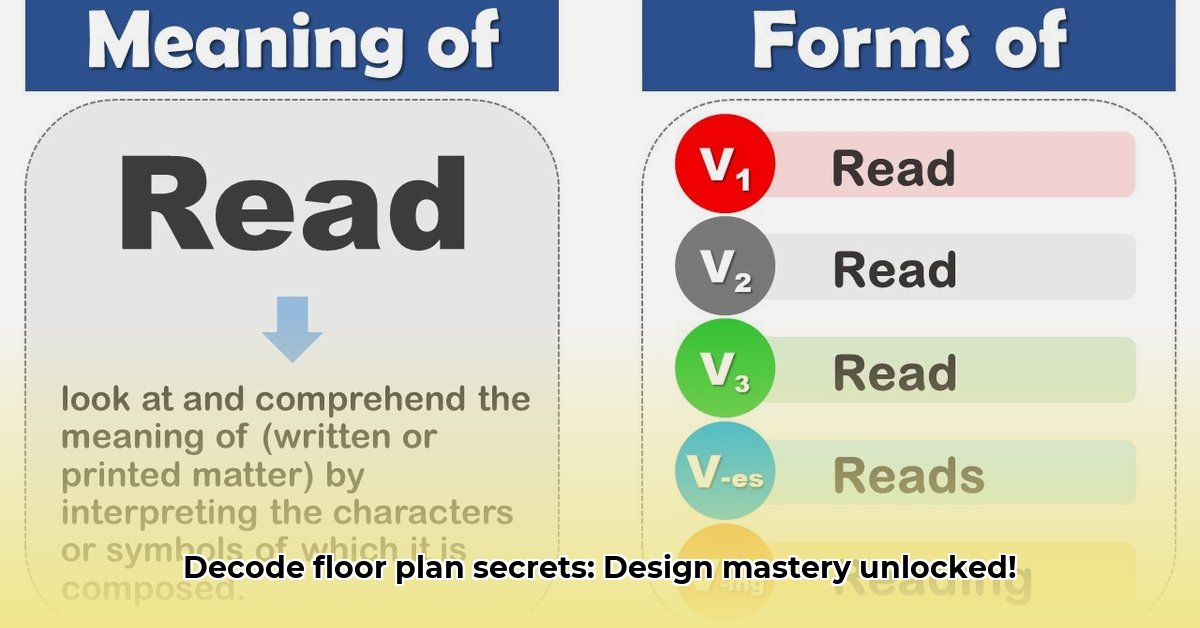Ever stared at a floor plan and felt completely lost? Like looking at a map in a foreign language? You’re not alone! Floor plans might seem confusing at first, but they’re actually pretty straightforward once you know the tricks. This guide will walk you through everything you need to understand those lines and symbols, turning you into a floor plan pro in no time. We’ll cover everything from basics like measuring rooms to more advanced concepts – think dissecting those symbols and figuring out how the whole thing comes together in real life. Whether you’re buying a house, planning a renovation, or just curious, this guide will give you the confidence to read and understand any floor plan. For more information on floor plans in general, check out this helpful resource: learn more.
How to Read a Floor Plan: Design Mastery Now
Let’s unlock the secrets of floor plans! They might look like confusing scribbles at first glance, but with a little know-how, you’ll be deciphering them like a pro. Floor plans are mini-maps of a building’s interior, showing the arrangement of rooms, walls, doors, and other features. Mastering how to read one opens a world of possibilities, whether you’re buying a house, planning a remodel, or simply curious about architecture. Understanding floor plans can also significantly aid in interior design and space planning.
Understanding Scale and Measurements: Sizing Up the Space
The first thing you need to understand is the scale. Think of a floor plan as a scaled-down model of a house. A common scale is 1/4″ = 1′, meaning every quarter-inch on the plan represents one foot in real life. This crucial information is usually printed somewhere on the floor plan itself, often in the title block. Find it – it’s your key to understanding the actual dimensions. Accurate measurements are critical for furniture placement, space optimization, and ensuring building code compliance.
Now, grab a ruler! Let’s say you’re measuring a living room on a floor plan. You measure the length on the plan, then use the scale to convert those inches into feet. For example, if you measure 6 inches and the scale is 1/4″ = 1′, the actual room length is 24 feet (6 inches x 4 inches/foot = 24 feet). It’s basic math, but incredibly important. Practice with a few different measurements to get the hang of it. This knowledge will give you an advantage when planning renovations. Accurately calculating dimensions from a plan can prevent costly material overages, and also helps in determining the proper size of HVAC systems.
Deciphering Common Symbols: The Language of Floor Plans
Next, we tackle the symbols – the visual shorthand used on floor plans. Imagine them as a universal code that builders and architects use to communicate efficiently. A floor plan is packed with icons representing everything from doors and windows to toilets, appliances, and electrical outlets. While many symbols are standardized by organizations like the American National Standards Institute (ANSI), some might vary depending on the architect or region, so always check the plan’s legend or key if one is provided. Being able to interpret these symbols provides a deeper understanding of the architectural drawings, which leads to fewer mistakes and better communication.
Here’s a quick guide to some common symbols you’ll likely encounter:
| Symbol | Description | Alternative Representations |
|---|---|---|
| ☐ or Thick line | Exterior Wall | Hatching or different line weight |
| ═ or Thin line | Interior Wall | Dashed line (for partition) |
| 🚪 or Arc | Door | Double doors, sliding doors |
| jendela or Break in wall | Window | Casement, awning, skylight variations |
| △ or Series of lines | Staircase | With arrow indicating direction |
| WC or Circle with line | Toilet | Elongated or corner toilet |
| ○ or Stylized shape | Sink | Single or double bowl, vanity |
| bathtub symbol or Rectangle | Bathtub | Whirlpool, freestanding tub variations |
| ⚡ | Electrical Outlet | Duplex, GFCI variations |
| 💡 | Light Fixture | Ceiling, wall-mounted variations |
Don’t worry if you don’t recognize every symbol immediately. The key is to look for patterns and context. Practice makes perfect! Start by identifying the basic shapes, like rectangles for walls and smaller shapes for fixtures. Recognizing symbols allows you to quickly identify key elements like doors, windows, and plumbing and electrical fixtures, which is very important in making informed decisions about layouts. Online resources and architectural dictionaries can be helpful for deciphering unfamiliar symbols.
Interpreting Specific Features: Walls, Windows and More
Walls define the boundaries of rooms. The thickness of the lines used to draw walls often indicates whether they are exterior or interior walls, and sometimes if they are load-bearing walls (thicker lines typically indicate load-bearing). Knowing if a wall is load-bearing is critical if you are planning any renovations—you can’t just knock down a load-bearing wall without significant structural reinforcement! Removing a load-bearing wall without proper support can lead to structural collapse. Consult with a structural engineer before making any changes to load-bearing walls.
Windows and doors are more than just openings. Their size, type (casement, sliding, double-hung), and placement heavily influence the amount of natural light, ventilation, and privacy a room receives. While the exact dimensions might not always be explicitly stated, the symbols provide a good general idea. Door swing direction is also important to note, as it affects traffic flow and furniture placement. Staircases connect different floors. Their location, dimensions, and the presence of handrails are crucial for both architectural design and safety. Pay close attention to the placement of plumbing fixtures (toilets, sinks, showers, tubs) and electrical outlets. This is especially important if you’re thinking about remodeling a bathroom or kitchen. Understanding the placement of these elements can save you time and money during a renovation.
Advanced Techniques: Unveiling the Nuances
Let’s delve into some more advanced features. You might stumble upon notations like “open to below” or “vaulted ceiling”. This often means the room extends upward, creating an open space connecting multiple levels or a higher ceiling than standard. This is often seen in open-concept homes or loft spaces. Understanding “open to below” impacts design and structural integrity if you want to make changes.
Centerline dimensions are another common feature. These are measurements taken from the center of a wall, rather than the outside edge. This means you’ll need to account for the wall’s thickness when calculating the actual room dimensions. Typically, the wall thickness will be noted elsewhere on the plan. A compass rose or north arrow, if present, indicates the building’s orientation relative to north, south, east and west—valuable information for understanding sunlight exposure, energy efficiency, and prevailing winds. Many floor plans may even include suggested furniture placements. These are helpful hints for visualizing the space, but remember: they are suggestions only and may not be to scale. This knowledge gives you a more in-depth understanding of space, environmental control, and design intent. Pay attention to ceiling heights, which may be noted, especially in areas with dropped ceilings or variations in height.
Using Floor Plans for Different Purposes: Tailoring Your Approach
The way you approach a floor plan depends on your purpose. A homebuyer will focus on the overall layout, room sizes, the flow between rooms, and the location of key features like bathrooms and kitchens. They’re looking at the big picture and how the house fits their lifestyle. An architect, however, might scrutinize structural details, wall thicknesses, construction methods, and adherence to building codes. They’re interested in the underlying structure and ensuring the building is safe and sound. A renovator will pay close attention to the placement of plumbing, electrical outlets, HVAC systems, and other utilities – details crucial to their planning and budget. Therefore, the same floor plan can tell very different stories to different people. This ability to adapt your floor plan reading skills based on your role enables focus on the elements that are most important to you, which enhances the design or evaluation process.
For example, the most important difference between an Architect and a Homebuyer when reading floorplans lies in their priorities: an Architect seeks code compliance and structural integrity, while a Homebuyer looks for functionality and lifestyle fit.
Limitations of Floor Plans and Helpful Resources: Filling the Gaps
Remember, floor plans have limitations. They don’t typically include details like the type of materials used (flooring, countertops, paint colors), the exact specifications of mechanical, electrical, and plumbing (MEP) systems (wiring, pipe materials, ductwork), or the precise specifications of all windows and doors (sizes, types of glass, hardware). They also may not show the slope of the land or landscaping features. To get complete information, you might need to consult additional documents, like construction details, elevations, sections, schedules, or even contact the builder, architect, or other consultants directly. Addressing the limits of any floorplan and supplementing it with extra resources enhances project planning by reducing risks and ensuring accurate execution.
To help you visualize the space further, consider using online tools and apps. Many offer 3D modeling capabilities, letting you virtually “walk through” the space based on the floor plan. These are invaluable aids for understanding a floor plan’s layout and scale. For complex projects, seeking advice from a professional architect, interior designer, or contractor is always a good idea.
How to interpret unclear floor plan symbols and dimensions
Key Takeaways:
- Understanding scale is fundamental to accurate measurements.
*
- Gray Kitchen Backsplash Ideas: Find Your Perfect Gray Tile - December 11, 2025
- Glass Wall Tiles For Bathroom: A Stylish, Durable Choice - December 10, 2025
- Glass Mosaic Kitchen Backsplash: Add Shimmer and Style - December 9, 2025









